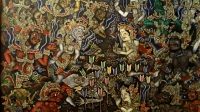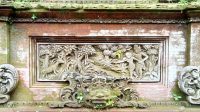BALI ISLAND is a cultural canvas carved with detailed artistry and profound spirituality. In every corner, from majestic temples to humble homes, we’ll find statues of various shapes and meanings. One of the most prominent and easily recognizable is the Dwarapala statue. These statues often greet us at the gate, standing tall with fierce faces and mighty postures.
However, behind their intimidating appearance, Dwarapala harbor a function and philosophy far deeper than mere decoration.
Getting to Know the Figure of Dwarapala
Etymologically, the name “Dwarapala” comes from Sanskrit, consisting of two words: dwara meaning “gate,” and pala meaning “guard.” Thus, Dwarapala are gatekeeper statues. In the Hindu-Buddhist tradition, this concept is very common and can be found at various ancient sites throughout Southeast Asia.
These statues are usually depicted as giant figures with imposing, muscular postures, often wielding weapons such as clubs or swords. They are always found in pairs, placed to the right and left of the entrance, as if ready to face any threat.
In Bali, Dwarapala statues are not simply statues, but rather the embodiment of Guardian Gods tasked with protecting sacred places from evil influences, both physical and spiritual. They are symbols of strength and authority, maintaining the sanctity of the areas within them, such as temples, palaces, or even traditional Balinese homes.
Materials and Manufacturing Process
Dwarapala statues in Bali are generally made from paras or sand stone, or cadas stone, which is easily found and carved in Bali. Paras stone has a relatively soft texture, making it easy for local artists, often called undagi or carvers, to carve them with fine detail. In addition to paras stone, some statues are also made from andesite, which is known to be harder and more durable.
The process of making them is a ritual in itself. The artists do not only rely on technical skill but also on the philosophical meaning of the statues they carve. Every carving, from the firm facial expressions, the weapons held, to the headdresses, has a symbolic meaning that must be conveyed precisely. This makes each Dwarapala statue unique, reflecting the interpretation and artistry of its creator.
The Secret Behind the Scary Face
The most frequently asked question is: why does the Dwarapala face look so scary? Its bulging eyes, bared fangs, and ferocious expression often make people shudder. However, this face is not intended to frighten visitors, but rather to emphasize its spiritual function.
This frightening face is a manifestation of the power of Asura, or the forces of darkness that have been subdued and are now used for good. In Hindu mythology, Asura is a powerful entity often depicted with a frightening appearance. By making the Dwarapala have the face of an Asura, the statue symbolically conveys its extraordinary power to ward off negative energy, evil spirits, and ill intentions that seek to desecrate the sanctity of the place.
Its fierce expression and bared fangs are a visual representation of a “guardian” who will not compromise in his duties. It is a spiritual fortress that guards the boundary between the profane (outer) and sacred (inner) worlds.
Philosophical Function and Meaning
More than just a physical gatekeeper, the Dwarapala has profound philosophical functions and meanings:
- Spiritual Boundary Guardian: The Dwarapala symbolizes the boundary between the profane and sacred worlds. Its position at the gate reminds everyone who wishes to enter that they must leave behind any ill intentions and impure thoughts. It seems to filter the intentions and energies of each visitor.
- Reminder of Cosmic Balance: The presence of the fierce-faced Dwarapala in a sacred place symbolizes the principle of Rwa Bhineda, which is the balance between two opposing forces (basic dualism). In this case, the fearsome force (Asura) is used to protect the good (the sacred place). This is a reminder that in the universe, the forces of darkness and light complement each other and are necessary to maintain balance.
- Symbol of Transformation: The Dwarapala can also be interpreted as a symbol of self-transformation. The initially “negative” force (Asura) is transformed and directed toward a “positive” purpose. This teaches that every individual has the potential to transform their inner darkness into a force for good.
Every time we pass through a gate guarded by a Dwarapala statue, we are not just stepping into a building, but also into a spiritually guarded space. Its presence is a reminder that good intentions are key, and that beneath the calm sacredness, unseen forces are at work. (*)










